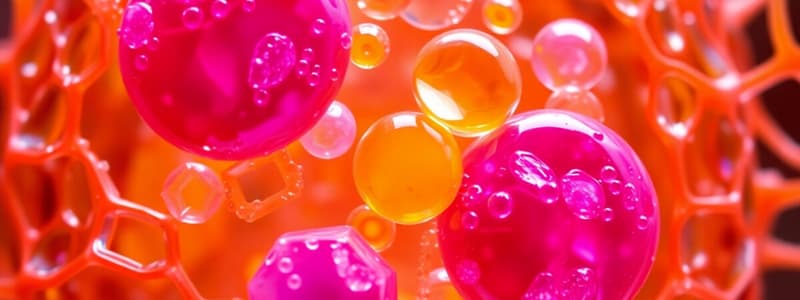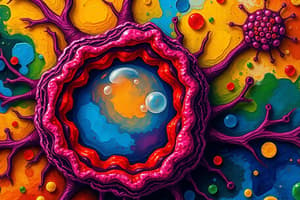Podcast
Questions and Answers
¿Cuál de las siguientes estructuras NO se encuentra en una célula eucariota?
¿Cuál de las siguientes estructuras NO se encuentra en una célula eucariota?
- Lisosomas
- Plasmodesmos (correct)
- Mitocondrias
- Centríolos
¿Qué organelo se encarga principalmente de la síntesis de proteínas?
¿Qué organelo se encarga principalmente de la síntesis de proteínas?
- Aparato de Golgi
- Mitocondrias
- Vacuolas
- Retículo endoplasmático (correct)
¿Cuál es la función principal de las mitocondrias en una célula eucariota?
¿Cuál es la función principal de las mitocondrias en una célula eucariota?
- Transporte de proteínas
- Síntesis de lípidos
- Respiración celular (correct)
- Almacenamiento de nutrientes
¿Qué componente celular regula el paso de sustancias hacia dentro y fuera de la célula?
¿Qué componente celular regula el paso de sustancias hacia dentro y fuera de la célula?
¿Qué organelo es responsable de la modificación y empaquetamiento de las proteínas?
¿Qué organelo es responsable de la modificación y empaquetamiento de las proteínas?
¿Qué afirmación es cierta respecto a la composición de los organismos vivos?
¿Qué afirmación es cierta respecto a la composición de los organismos vivos?
¿Cuál fue un factor clave en el avance del estudio celular?
¿Cuál fue un factor clave en el avance del estudio celular?
¿Qué distingue al microscopio electrónico del microscopio óptico en el estudio de las células?
¿Qué distingue al microscopio electrónico del microscopio óptico en el estudio de las células?
¿Cuál de las siguientes afirmaciones es incorrecta sobre los tipos de organismos mencionados?
¿Cuál de las siguientes afirmaciones es incorrecta sobre los tipos de organismos mencionados?
¿Qué aspecto de la biología celular se benefició de la creación del microscopio electrónico?
¿Qué aspecto de la biología celular se benefició de la creación del microscopio electrónico?
Flashcards
Núcleo
Núcleo
La parte central de una célula eucariota que contiene el material genético (ADN).
Retículo endoplasmático
Retículo endoplasmático
Una red de membranas que se extiende por todo el citoplasma de las células eucariotas.
Aparato de Golgi
Aparato de Golgi
Un sistema de membranas plegadas en el citoplasma de las células eucariotas, funciona como una fábrica de envases.
Mitocondrias
Mitocondrias
Signup and view all the flashcards
Centríolos
Centríolos
Signup and view all the flashcards
Células
Células
Signup and view all the flashcards
Microscopio Óptico
Microscopio Óptico
Signup and view all the flashcards
Microscopio Electrónico
Microscopio Electrónico
Signup and view all the flashcards
Estudio de las Células
Estudio de las Células
Signup and view all the flashcards
Importancia del Estudio Celular
Importancia del Estudio Celular
Signup and view all the flashcards
Study Notes
General Organization of Organisms
- Living organisms can be unicellular or multicellular, with multicellular organisms being more complex structurally.
- Fundamental structural levels include:
- Chemical level: basic structures forming cells (atoms and molecules), no vital functions.
- Cellular level: basic unit of life, carries out vital functions like reproduction, relationship, and nutrition.
- Tissue level: association of cells, carries out specialized functions.
- Organ level: various tissue associations, performing complex functions.
- Systems and apparatuses (organism):
- Systems: collections of similar organs working independently, for a specific function (9 systems).
- Apparatuses: collections of different organs working together (6 apparatuses).
Cell Structure
- Cells are the structural and functional units of living things.
- They carry out vital functions (nutrition, relationship, reproduction).
- Cells can be:
- Prokaryotic: lack a defined nucleus, genetic material (DNA) is free in the cytoplasm.
- Examples of prokaryotic cells are bacteria.
- Size range is between 1 and 10 micrometers.
- Eukaryotic: possess a well-defined nucleus, genetic material (DNA) enclosed by a nuclear membrane.
- All cells share common structures: plasma membrane, cytoplasm, and genetic material (DNA).
Cell Types and Structure
- Eukaryotic cells have various organelles in their cytoplasm:
- Nucleus
- Nucleolus: site of ribosome production
- Endoplasmic reticulum (ER):
- Rough ER: ribosomes attached, protein synthesis.
- Smooth ER: lipid synthesis, detoxification.
- Golgi apparatus: modifies, sorts, and packages proteins.
- Mitochondria: site of cellular respiration.
- Lysosomes: break down cellular waste.
- Vacuoles: storage compartments.
- Ribosomes
- Plasma membrane
- Cell structures vary depending on cell type (e.g., plant cells, animal cells).
Cell Function: Nutrition
- Nutrition is how organisms procure and use nutrients for survival.
- Cells intake nutrients in various ways:
- Passive transport: movement of substances across the membrane without energy input (diffusion, facilitated diffusion, osmosis, ultrafiltration).
- Active transport: movement of substances against a concentration gradient, requiring energy (ATP).
Cell Function: Reproduction
- Reproduction is the process by which organisms create new individuals.
- Mitosis: cell division, producing two identical daughter cells.
- Phases: prophase, metaphase, anaphase, telophase, cytokinesis.
- Meiosis: cell division involved in sexual reproduction, producing daughter cells with half the number of chromosomes.
Cell Function: Relationship
- Relationship, also known as "reception and response" in cells refers to how cells react to stimuli.
- Cells receive stimuli from the environment either internally or externally.
- Cells respond to stimuli using several mechanisms that help them survive, and function properly in their environment.
- Communication, between cells, allows them to work together in a coordinated manner.
Tissue Types
- Epithelial tissue: Covers body surfaces, lines body cavities, forms glands.
- Classification by layering (simple, stratified, pseudostratified) and shape (squamous, cuboidal, columnar).
- Function: protection, secretion, absorption, excretion.
- Connective tissue: Supports, connects, and separates different tissues and organs in the body.
- Classification: Loose connective tissue, dense connective tissue, cartilage, bone, blood.
- Function: support, protection, insulation, transportation.
- Muscle tissue: Contractile tissue, responsible for movement.
- Classification: Skeletal muscle, cardiac muscle, smooth muscle.
- Function: movement, support, heat production
- Nervous tissue: Processes information and coordinates body functions.
- Classification: Neurons, neuroglia.
- Function: communication, control, coordination
Human Body Organization
- Human Organs: Specific configurations of tissues that provide a particular function.
- Examples: heart, lungs, brain, kidney, skin, liver
- Systems: Groups of organs that work together to perform a major function.
- Examples: digestive system, circulatory system, nervous system, etc.
- Organs systems are comprised of groups of organs working collaboratively to fulfill a specific function.
Human Body Planes, Regions, and Cavities
- Body Planes: Imaginary lines used to section the body for description purposes.
- (Frontal, sagittal, transverse)
- Body Regions: Divisions of the body for clinical and anatomical descriptions.
- Body Cavities: Internal spaces that enclose vital organs.
- (Dorsal cavity, ventral cavity (thoracic and abdominal cavities)
Blood Composition (Tissue Type)
- Blood: Specialized connective tissue. Fluid matrix (plasma), cells (red blood cells, white blood cells, platelets).
- Function: transportation, immunity, blood clotting.
Blood Types
- Blood types are determined by the presence or absence of specific antigens on red blood cell surfaces.
- ABO system (A, B, AB, O) and Rh factor (positive or negative)
- Blood typing is crucial for transfusions and diagnosing diseases like blood disorders.
Studying That Suits You
Use AI to generate personalized quizzes and flashcards to suit your learning preferences.




